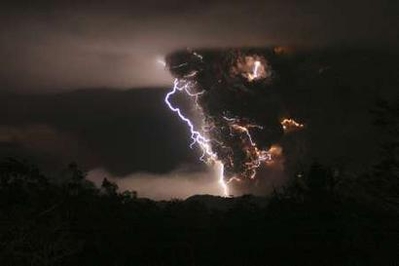Electromagnetic Energy May Hold the Key to Climate Change
Politics / Climate Change May 31, 2008 - 04:29 AM GMTBy: Brian_Bloom

 One of the six topical themes of the storyline in Beyond Neanderthal is the likely impact of Climate Change on world-wide agricultural production and what we might do about that. Importantly, our response will need to be tailored to address causes, not symptoms. When I watched Al Gore's body language in the documentary, An Inconvenient Truth , I formed the view that his stepping onto that scissor lift was an act of salesmanship. This bothered me. If the “science is settled” why was this obviously sincere man in hard-sell mode? Did he lack confidence that the facts spoke for themselves? It was then I decided that – for the purposes of ensuring integrity of Beyond Neanderthal's storyline – it would be necessary for me to do my own detailed research as to the likely causes of Climate Change.
One of the six topical themes of the storyline in Beyond Neanderthal is the likely impact of Climate Change on world-wide agricultural production and what we might do about that. Importantly, our response will need to be tailored to address causes, not symptoms. When I watched Al Gore's body language in the documentary, An Inconvenient Truth , I formed the view that his stepping onto that scissor lift was an act of salesmanship. This bothered me. If the “science is settled” why was this obviously sincere man in hard-sell mode? Did he lack confidence that the facts spoke for themselves? It was then I decided that – for the purposes of ensuring integrity of Beyond Neanderthal's storyline – it would be necessary for me to do my own detailed research as to the likely causes of Climate Change.
(Reader Note: The information contained in this article is far too complex to have been included in a novel in this format. Beyond Neanderthal is a factional novel which weaves a highly simplified version of the results of the research into an easy-to-read storyline which shows how a jigsaw puzzle of the novel's six themes, listed at the end of this article, fit together.)
Forces impacting on Climate Change
In summary, my desk research led me to conclude that the “drivers” of climate change are certainly not as cut and dried as the Intergovernmental Panel on Climate Change believes.
What most analysts and commentators appear to be focussing on is the change in global surface temperatures, which can be seen from the HadCRUT3 chart below (Source: http://www.metoffice.gov.uk /research/hadleycentre/obsdata /HadCRUT3.html ).
Since around 1860, ‘best estimate' temperatures have risen by about 1 o C, with half of this increase occurring in the last 25 odd years.
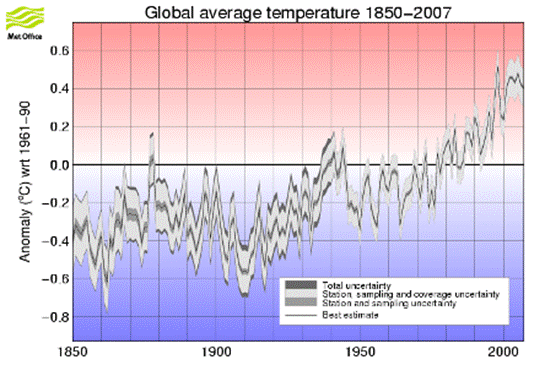
But focusing only on atmospheric temperature is like listening only to the “tick” of a grandfather clock. There is also a “tock”. Our oceans also play a role in climate. To quote from one particular article, “ .. the oceans and the atmosphere constitute intertwined components of Earth's climate system” (Source: http://www.whoi.edu/page.do ?cid=9986&pid=12455&tid=282 ).
When one listens to the “tock” one discovers the mechanism by which the seasonal storage and release of heat by our oceans also has an influence on Climate Change (For a detailed explanation see: http://www.ldeo.columbia.edu /res/div/ocp/gs/pubs/Seager _etal_QJ_2002.pdf )
Whilst the heat content of our oceans – to a depth of 3,000 meters – certainly rose overall from 1955 to 1998, it fell between 2003 and 2005. ( see http://www.pmel.noaa.gov /people/lyman/Pdf/heat_2006.pdf ). Common sense dictates that the 1955 -1998 rise could not possibly have been caused by the rising temperature of our atmosphere. The reason (apart from the 2003-2005 heat content reduction) relates to the significantly different amounts of heat energy required to raise the temperatures of the same quantities of water and air by one degree. This can be seen from the Table below.
Table 1: Indexed amount of heat energy required to effect an increase in temperature of one degree Celsius
(Note: Index Numbers have been rounded to the nearest meaningful number)
Comparative Quantities |
Water |
Air |
1 Kilogram each |
>4 |
1 |
1 Cubic Meter each |
>3,500 |
1 |
Total volume of water in oceans vs total volume of air in atmosphere |
>1,000 |
1 |
(Note: The “Specific Heat” of water is 4.181 and the Specific Heat of air is 1.0035. source: http://en.wikipedia.org/wiki /Heat_capacity#Heat_capacity )
The table shows that, everything else being equal, it would take over 1,000 times as much heat energy to raise the temperature of our oceans by one degree as it would take to raise the temperature of our atmosphere by one degree.
The relationships in Table 1 may be conceptualised in another way:
Heat transfer is not instantaneous. Just think of how long it takes to bring a kettle of cold water to boil on a red hot stove.
Thus, for example, if the temperature of our atmosphere increases by 1 o C over a period of one year because of greenhouse gas driven global warming (of which Carbon Dioxide is but one such gas) – and if the atmospheric temperature remains constant thereafter – it would take more than 1,000 years for that incremental heat energy to be transferred to our oceans so as to raise their overall temperature by one degree. This time frame falls dramatically outside the roughly 250 year period of the Industrial Revolution during which there has been an increase in anthropogenic CO 2 emissions.
It is now appropriate to consider the fact that the rate of flow of the Gulf Stream slowed by around 30% over the 12 years to 2005. (Source: http://www.timesonline.co.uk /tol/news/uk/article598464.ece )
What caused the Gulf Stream to slow?
It seems that this was related partially to the rising temperature of our oceans and partially to the lower level of salinity in the waters around the Ice Caps because the ice has been melting. (The Specific Heat of Ice is 2.05).
But it has already been demonstrated that there is no way the temperature of our oceans could have risen within such a short period as a result of our warming atmosphere. It would have been physically impossible.
Interim Conclusion
The argument that there is a cause-end-effect linkage between CO 2 levels in our atmosphere and global warming seems erroneous in context of the fact that the rate of flow of the Gulf Stream slowed by 30% in 12 years. Something else must have been causing both the temperature of our atmosphere and the heat content of our oceans to rise.
This interim conclusion casts considerable doubt on the statistical integrity of the IPCC model. Indeed, such doubt was already cast in November 2006 by Dr Edward Wegman, then Chairman of the National Academy of Sciences' Committee on Applied and Theoretical Statistics, and board member of the American Statistical Association. (Source: http://www.nationalpost.com /story.html?id=22003a0d-37cc -4399-8bcc-39cd20bed2f6&k=0 ).
The fact is that there are several examples which illustrate that the IPCC model has the capacity to be seriously misleading in its forecasts. One such example is Melville Island – where temperatures have shot up by 15 degrees C above normal. “On land at Mould Bay on the island's northwest side, his research team measured record-shattering temperatures of between 15 to 22 degrees C in July. Until then, the normal July average temperature had been between 4 and 5 degrees C.” (Source: http://www.commondreams.org /archive/2007/10/05/4348/ ). It is self evident that this could not possibly have been a consequence of greenhouse gases.
If CO 2 has not been causing global warming, what has been causing it?
The general consensus of the “other side” argument is that global warming has been caused by a cyclical increase in the sunspot activity on our sun's surface. It can be seen from the top chart below that, since around 1929 (the peak of cycle #16), the 11 year solar cycle has become more pronounced.
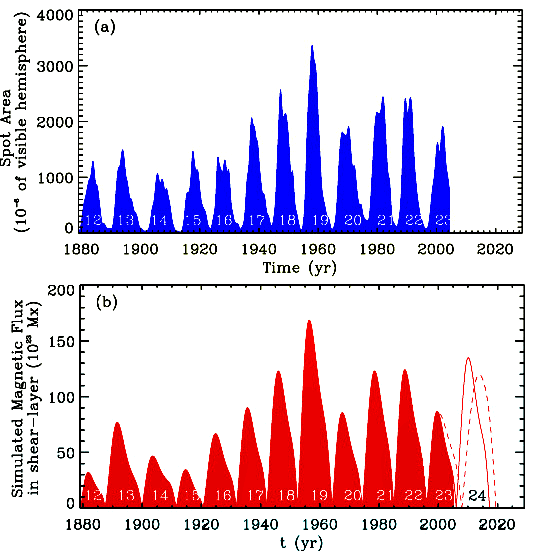
Source: http://www.ucar.edu/news /releases/2006/sunspot.shtml
Some climatologists attempt to rebut this on the basis that the measured irradiation arriving from our sun has shown little change. But, all one needs to do is look at the “Y” axis on the lower chart. Simulated magnetic flux has demonstrably increased by almost 100% relative to the 1880 – 1929 average. So who do we believe?
Well, let's apply some common sense: Arguably, if the surface of the earth is warmed by the sun's rays (demonstrably true); and the sun flares (which it demonstrably does); and if the average number of flares rises (which has demonstrably been the case since the 1930s) – then it will have been getting warmer on the earth's surface. One can play with statistics all one likes, but that logic seems unassailable. It is far more reasonable to conclude that greenhouse gases (including water vapour from the evaporating surfaces of the oceans) have served to trap the increased heat of our sun being reflected off the earth's surface, and that CO 2 emissions have been exacerbating global warming rather than causing it.
Conclusion
Common sense dictates that our more active sun must have been raising the temperature of our oceans; and that the warmer sunshine, together with the warmer oceans, together with warmer winds which they spawn, together with the greenhouse effect, has been melting our ice caps.
Looking Forward: What might we expect?
After writing Beyond Neanderthal , it struck me that the increased electromagnetic activity of our sun might have been having other consequences. For example, it might have been causing an increase in earthquakes and volcanic activity in addition to changed climate patterns.
Question: Are there any other symptoms of possible changes in the electromagnetic energy field of the earth which might further validate the above conclusion?
Answer: Yes – but it must be stressed that, as yet, there appears to be no cause and effect linkage between the increased intensity of solar flaring and these symptomatic changes. We are merely hypothesising at present.
- The linkage between pre-seismic electromagnetic anomalies and earthquakes has been scientifically validated. (For an example, see http://www.agu.org/pubs /crossref/2001/2001GL013124 .shtml ). In the recent past it “feels” like there has been an increase in the number of earthquakes. Most occur at the joints of the Tectonic Plates which float on an ocean of magma. Heat escaping from these joints might have served to warm the oceans' waters from below. I have done no research in this area, but was struck by the fact that the map below showed 341 earthquakes during the 7 days preceding May 7 th 2008. (Note: The 7.9 magnitude earthquake in Szechuan Province of China occurred on May 12 th 2008)
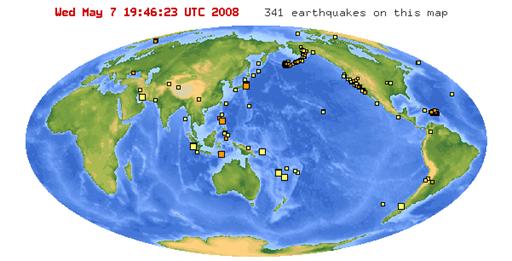
Source: http://earthquake.usgs.gov /eqcenter/recenteqsww/
- On May 2 nd 2008, the Chaiten volcano in southern Chile erupted. It had lain dormant since 7,400 BC. http://www.sciam.com/gallery _directory.cfm?photo_id =DE437859-E097-9DEF-EA64B135AA5 2CB17 . (Intriguingly, this eruption may have been linked to the 7.7 magnitude quake in northern Chile in November 2007.)
The following shows a possible linkage between volcanic eruptions and electromagnetic anomalies:
Reuters Sat May 10, 8:02 PM ET Lightning bolts appear above and around the Chaiten volcano as seen from Chana, some 30 kms (19 miles) north of the volcano, as it began its first eruption in thousands of years, in southern Chile May 2, 2008. Cases of electrical storms breaking out directly above erupting volcanos are well documented, although scientists differ on what causes them. Picture taken May 2, 2008. REUTERS/Carlos Gutierrez (CHILE) Photo Tools |
- The Colony Collapse Disorder (CCD) of the bees may be a “canary in the coal mine” symptom that something is happening to the earth's magnetic polarity. Whilst some scientists believe that the bees find their way back to the hive by following polarised lines of light in the sky, others argue that they have magnetic homing devices which allow them to return to their hives. (See: http://www.abc.net.au/science /k2/trek/4wd/Over57.htm ). The bees' failure to return to their beehives may have less to do with “abandonment” or “disease” and more to do with “getting lost”. (“ Curiously though no dead bees are found either inside or outside the hive ” Source: http://news.yahoo.com/s/afp /20070407/ts_alt_afp/sciencenat urebeesus_070407020928 , 7 th April 2007. Note: For those who are unfamiliar with CCD: “A survey of bee health released Tuesday revealed a grim picture, with 36.1 percent of the nation's commercially managed hives lost since last year. Last year's survey commissioned by the Apiary Inspectors of America found losses of about 32 percent.” Source: Associated Press News Article, May 7 th 2008).
Assuming for the moment that there may well be a cause and effect linkage between solar activity and changes in the earth's electromagnetic energy field, this, in turn, begs the question: What caused the increase in solar activity?
The answer to that question appears to be linked to the position of our sun within the galaxy and the impact of gravitational forces that are brought to bear on our sun as it travels along its elliptic path.
Not all the above issues are addressed in Beyond Neanderthal , but the underlying electromagnetic issues are addressed in some detail – specifically, the position of our sun in the galaxy. It is being forecast to reach a culmination point in its 26,000 year cycle on December 21 st , 2012; when its elliptic will intersect the Dark Rift of the Milky Way Galaxy. If this unfolding scenario is indeed impacting on the earth's electromagnetic field, then we might expect to experience more Myanmar cyclone type occurrences and also an increasing number and intensity of earthquakes and volcanic eruptions.
It is being anticipated by some that, from 2013 onwards the flaring on our sun's surface will begin to wane (if this is not already happening), and that the earth's surface will begin to cool again – perhaps culminating in mini Ice Age conditions by 2050. Such an outcome would be consistent with the cyclical nature of climate change as is reflected in the chart below (Source: Why Geography Matters, De Blij, Oxford University Press, 2005).

Peering into the future: A conceptual pathway forward
As a matter of philosophical principle, it seems to this author that all problems are either soluble or partially addressable – even those described above – provided we understand those problems. In pragmatic terms, there are specific actions that might be taken on a collaborative basis across the planet. In relation to the above cases in particular the problems may either be addressed or ameliorated by the appropriate application of available technical knowhow. We have access to some extraordinarily powerful technologies.
But before we act, it needs to be recognised that a basic principle of problem solving is: “First, define the problem”. The evidence suggests that the IPCC may have defined the problem incorrectly. A higher level perspective of the broader evidence suggests that CO 2 is not the problem and therefore we have a “crap-shoot” chance of appropriately addressing the issues which will flow from climate change, one of which will be pressures on agricultural capacity to feed the world's population.
For example, just like the “biofuels from corn and/or soybeans” concept – which gave rise to food shortage related rioting in thirteen countries in less than a year after the passage of the Energy Independence and Security Act of 2007 (H.R. 6) – the concept of carbon credit trading does not stand up to scrutiny. How, precisely, will such a course of action address the driver of climate change if CO 2 is not the driver?
For that matter, even if CO 2 was the driver, it seems likely that carbon credit trading will inhibit the economic development of under-developed countries. Surely, encouraging them to sell their “right” to produce carbon emissions will also serve to discourage them from becoming net contributors to global Gross Domestic Product. That appears seriously counterproductive when viewed from an economic perspective. This is not to say we should not aspire to reduce CO 2 emissions. Of course we need to reduce the level of all pollutants!
Hopefully, Beyond Neanderthal will broaden the scope of discussion to allow a better understanding of the issues that are impacting on the problems being faced by humanity. There are solutions – some of which are put forward in the novel – but we need to tailor the solutions to the real problems as opposed to the perceived problems. Two new (patented) electromagnetic energy technologies are introduced – neither of which is yet on the commercial radar. Neither of these will see the light of day if we are to rely on Private Enterprise to commercialise them. Both – provided their claims can be validated – could be economically stimulative; and may even have the capacity to drive the world economy for the next 100 years in the way oil and related technologies drove the economy in the past 100 years. One of these may have the capacity to replace fossil fuels entirely. The other may have the capacity to dramatically increase agricultural yields in currently infertile regions – which implies that the world's poorer nations might become breadbaskets to the world. i.e. By implication, the poorer nations should be encouraged to join the global economy, not stay out of it.
An easy-to-read, entertaining and light-hearted storyline – in a novel format – was selected as the means of communicating Beyond Neanderthal's information to as broad a readership as possible. The six themes of the novel are:
- The rickety World Economy (It is growing in currency terms but may be shrinking in volume terms)
- Climate Change
- Clash of Civilisations
- Testosterone and its impact on the attitudes and behaviour of society's decision makers
- Alternative Energy Technologies to replace fossil fuels
- Life and Love are wondrous gifts to be treasured and joyfully celebrated.
Beyond Neanderthal also offers clear explanations in layman's language regarding all of the above and makes specific (step-by-step) proposals regarding what we might do to address all of these issues. Beyond Neanderthal's website has been redesigned to make the author's web-based research available to those who purchase a copy of the novel – which can now be ordered at www.beyondneanderthal.com
Brian Bloom
Author, Beyond Neanderthal
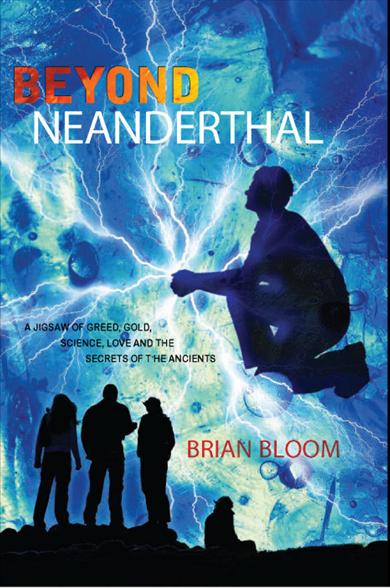
There is an energy force in the world—known to the Ancients—that has largely escaped the interest of the media, the global warming soothsayers and the oil companies seeking alternatives to Neanderthal fire—to fossil fuels. Why? There are allusions to this energy in the Chinese I-Ching, in the Hebrew Torah , in the Christian Bible , in the Hindu Sanskrit Ramayana and in the Muslim Holy Qur'an . There are scientists, too, who today believe it was the key to building the Egyptian pyramids. Its force is strongest within the Earth's magnetic triangles. Near one of these––the Bermuda Triangle–– circumstances bring together four very different people. Patrick Gallagher is a mining engineer searching for a viable alternative to fossil fuels; Tara Geoffrey, an airline pilot on holidays in the Caribbean; Yehuda Rosenberg, a physicist preoccupied with ancient history; and Mehmet Kuhl, a minerals broker, a Sufi Muslim with an unusual past. Can they unravel the secrets of the Ancients that may also hold the answer to the future of civilization? |
Copyright © 2008 Brian Bloom - All Rights Reserved
Brian Bloom Archive |
© 2005-2022 http://www.MarketOracle.co.uk - The Market Oracle is a FREE Daily Financial Markets Analysis & Forecasting online publication.



